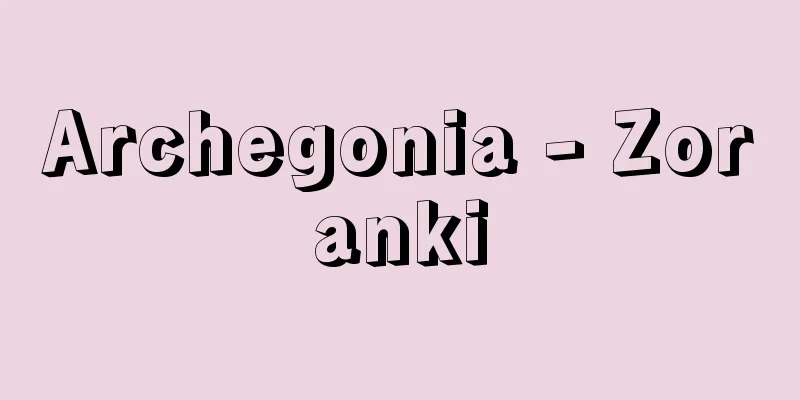Archegonia - Zoranki

|
It is an organ that forms female gametes (also called egg cells or female reproductive cells) in charophytes, bryophytes, and ferns, and is distinguished from the ovipositional apparatus of algae and fungi due to its unique structure. In Charophytes, five tubular cells are formed on a base cell that is formed by the projection of epidermal cells at the node (branching point of the leaf), and these cells spirally form a spherical archegonia. There is one egg cell, which is formed at the end of a stalk cell that is formed at the tip of the base cell. One or two small cells differentiate at the tip of the tubular cell, called a corona, which becomes the entrance for sperm. The archegonia of mosses and ferns are formed from the epidermal cells of the gametophyte, with the abdomen differentiated within the gametophyte tissue and the neck differentiated on the outside. The abdomen consists of a single layer of wall cells, and one egg cell and one ventral groove cell are formed inside. The neck consists of four rows of neck cells, and each row is formed of several cells, protrudes to the outside of the gametophyte, and gives rise to neck groove cells inside. There are three neck groove cells in mosses and one (binucleate) in ferns. When the archegonia ripens, the neck groove and ventral groove cells dissolve and are released outside the archegonia, where they act as sperm attractants. In ferns, which produce heterospores, the archegonia is formed within the shell of the megaspore. Archegonia are also found in gymnosperms, but in those plants they are a degenerate form that arises from a single cell on the surface of the embryo sac and consists of one egg cell, one ventral groove cell, and two neck cells. [Yasuda Keisuke] Source: Shogakukan Encyclopedia Nipponica About Encyclopedia Nipponica Information | Legend |
|
車軸藻植物、コケ植物、シダ植物の雌性配偶子(卵細胞、雌性生殖細胞ともいう)を形成する器官のことで、その特有な構造から藻類や菌類の生卵器とは区別されている。 車軸藻類では、節(せつ)(葉の分岐点)の部分の表皮細胞が突起して生じた台細胞上に形成される5本の管状細胞が、螺旋(らせん)状に巻いて球形の造卵器となる。卵細胞は1個で、台細胞の先端に生じる柄細胞の先に形成される。管状細胞の先端には1~2個の小細胞が分化し、小冠(しょうかん)とよばれ、精子の入口となる。 コケ植物、シダ植物の造卵器は配偶体の表皮細胞から形成され、配偶体の組織内に腹部、外側に頸(けい)部が分化する。腹部は1層の壁細胞からなり、内部に卵細胞と腹溝細胞とを1個ずつ形成する。頸部は4列の頸細胞からなり、各列は数個の細胞で形成され、配偶体の外部へ突出し、内部に頸溝細胞を生じる。頸溝細胞の数は、コケ植物では3個、シダ植物では1個(二核性)である。造卵器が熟すと頸溝、腹溝細胞は溶けて、造卵器の外へ放出され、精子の誘引物質として働く。異形胞子を生じるシダ植物では、造卵器は大胞子の殻中で形成される。 造卵器は裸子植物にもみられるが、裸子植物の場合は、胚嚢(はいのう)の表面の1細胞から生じ、各1個の卵細胞、腹溝細胞と、頸細胞2個からなる退化した型である。 [安田啓祐] 出典 小学館 日本大百科全書(ニッポニカ)日本大百科全書(ニッポニカ)について 情報 | 凡例 |
<<: Archegoniatae - Archegoniatae
>>: Gift tax - Zouyozei (English spelling) gift tax
Recommend
Ferdinand [II] - Ferdinand
King of Aragon (reigned 1479-1516). He married Pri...
Okapi - Okapi (English spelling)
An animal of the order Artiodactyla, class Mammal...
Symphonic poem
A type of program music for orchestra that is bas...
Market coins - Ichibasen
In the Middle Ages, a tax imposed on markets withi...
Tanuma [town] - Tanuma
A former town in Aso County in southwest Tochigi P...
Jigme Singi Wangchuk (English)
…[Toshiaki Oji] [Toshihiro Tsukihara]. … *Some of...
Iga
It is part of the cupule, which is a modified for...
Jack Nicklaus
…Winning all four major tournaments in one year i...
Home Oni
…(3) Location-moving type: The child moves freely...
Kakairou Ritsuri - Kakairou Ritsuri
...A kyoka poet from the mid-Edo period. His surn...
Baillie, M.
… [History of research into pulmonary tuberculosi...
Kutsuki [Village] - Kutsuki
A village in Takashima County, northwest of Shiga ...
Iwami [town] - Iwami
A town in Iwami County in eastern Tottori Prefectu...
Osteogenesis imperfecta
What is the disease? There are several classifica...
Honorific language - Keigo
It is a specific language form used by a speaker ...









